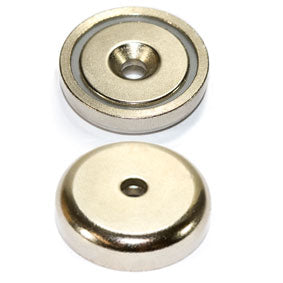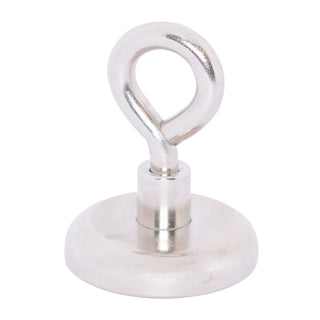Strong Magnets
 Strong magnets are used in many different businesses to hold, lift, carry and release a whole range of goods and items. Industries such as electrical motor manufacture, medical science, renewable energy and technology all rely on the super-strength neodymium magnets.
Strong magnets are used in many different businesses to hold, lift, carry and release a whole range of goods and items. Industries such as electrical motor manufacture, medical science, renewable energy and technology all rely on the super-strength neodymium magnets.
What are the strongest magnets made of?
The strongest available permanent magnets (i.e., magnets that retain their magnetic properties in the absence of an electrical current or some other magnetic field) consist of compounds of neodymium, a rare earth metal with atomic number of 60 and symbol of Nd. Neodymium magnets are actually made of an alloy of neodymium, iron, and boron. Alloys of different elements make stronger, longer-lasting magnets because pure magnetic materials usually demagnetize quickly. Neodymium magnets are often coated with nickel, which is less likely to chip or corrode.
Magnet Grades
Neodymium magnets are available in different grades, from N35 up to N52. The higher the value, the stronger the magnet. The strongest neodymium grade available is Grade N52. If there are letters after the grade number they refer to the heat tolerance of a magnet. For more information about grades you can see this article on Magnet Grades.
How to handle very strong magnets
Many strong magnets are so powerful that they are difficult to hold apart with your fingers and can be extremely difficult to separate once they become stuck to each other. To make magnets easier to separate, place a non-magnetic spacing material between them, e.g. a piece of plastic, wood or cardboard. Avoid handling multiple magnets at the same time unless they are properly stacked together with separators, or are kept well apart.
![]() When handling very strong magnets, we highly recommend you wear heavy protective gloves. Unsafe handling can result in fingers or skin being jammed in between magnets, causing contusions, bruises, or cuts. Very large powerful magnets can even cause bone fractures.
When handling very strong magnets, we highly recommend you wear heavy protective gloves. Unsafe handling can result in fingers or skin being jammed in between magnets, causing contusions, bruises, or cuts. Very large powerful magnets can even cause bone fractures.
***Please refer to our Magnet Safety Warning page.
To separate one magnet from each other, slide them apart. For stronger magnets that are difficult to slide, place them on a durable, non-metal surface, e.g. a workbench. Position the magnet to be separated so that it hangs out past the edge of the bench. Use one hand to firmly hold the row of magnets. Use the other hand to firmly hold the magnet you are separating. Push down and away from the row of magnets. Hold the separated magnet in your fist and immediately move it away from the other magnets.
Use caution when working with strong magnets!
 The magnetic pull force associated with very strong magnets can cause damage to cell phones, computers, magnetic recording devices, credit cards, electronic items, small motors, pace makers, etc. It is very important to maintain a safe distance between these items and strong magnets. It is also very important to make sure that sharp metal objects like scissors, knives, steel tools, and any other sharp metal objects are kept at a safe distance from very strong magnets.
The magnetic pull force associated with very strong magnets can cause damage to cell phones, computers, magnetic recording devices, credit cards, electronic items, small motors, pace makers, etc. It is very important to maintain a safe distance between these items and strong magnets. It is also very important to make sure that sharp metal objects like scissors, knives, steel tools, and any other sharp metal objects are kept at a safe distance from very strong magnets.
***Magnets are not suitable for small children, and should be kept out of reach at all times.
Check out some of our strongest Neodymium magnets:
Not enough in stock. Please choose a lower quantity.
Minimum order quantity is 1
Not enough in stock. Please choose a lower quantity.
Minimum order quantity is 1
Not enough in stock. Please choose a lower quantity.
Minimum order quantity is 1
Not enough in stock. Please choose a lower quantity.
Minimum order quantity is 1
Not enough in stock. Please choose a lower quantity.
Minimum order quantity is 1
Not enough in stock. Please choose a lower quantity.
Minimum order quantity is 1
Not enough in stock. Please choose a lower quantity.
Minimum order quantity is 1
Not enough in stock. Please choose a lower quantity.
Minimum order quantity is 1
Not enough in stock. Please choose a lower quantity.
Minimum order quantity is 1
Not enough in stock. Please choose a lower quantity.
Minimum order quantity is 1
















